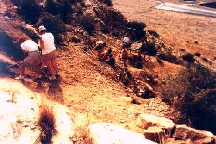
Plate 11: Sima de las Palomas: clearing dirt and rubble from the hillside above the mine level entrance. (Photo M. J. Walker)
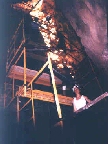
Plate 12: Sima de las Palomas: erecting the 18 metre high scaffolding tower. (Photo M. J. Walker)
Challenging field problems at both sites involved almost as much engineering as archaeology. Sima de las Palomas' breccia column necessitated building a scaffolding tower inside the shaft, but this required both prior clearance and sieving of rubble in the mine level and at the foot of the breccia column (Plate 6) where it formed a 4m high sloping pile of dirt and scree, and installation of security gates and grilles over both upper mouths and in the mine level. Before that, in 1992-3, we sieved rubble thrown out of upper entrances by the miners, strewn over the hillside's 45º rocky slope (Plate 11); luckily, it provided hominid bones, extinct animal remains, and middle palaeolithic artifacts. Three animal bone splinters encrusted in breccia were sent to Peter Pomery and David Hunter at Queensland University, Department of Chemistry, who offered three electron spin resonance estimates: 83,000/42,000 BP, 146,000/73,000 BP, and 532,000/266,000 BP - each alternative depends on whether background irradiation averaged 1 or 2 Gray per millennium (Gibert et al. 1994).

Plate 11: Sima de las Palomas: clearing dirt and rubble from the hillside above the mine level entrance. (Photo M. J. Walker)

Plate 12: Sima de las Palomas: erecting the 18 metre high scaffolding tower. (Photo M. J. Walker)
Budgetary limitations obliged us to clean and refurbish used scaffolding made available by the regional authorities, load and unload it, carry it up the hillside in July morning temperatures of 45ºC, and coax its 1.70m pieces lovingly through the mine level whose arched roof barely reaches 1.72m. In 1994 we hired - and helped - a rigger from Spain's ULMA scaffolding company to build up a tower in stages offset against the inclined breccia column (Plate 12). Once built, we could survey the cave accurately, drawing up a ground plan and an elevation (Figure 5, Figure 6) in order to locate our excavations in different parts of the cave with precision.
Access from our tower lets us trowel soil at the top of the column under the rocky overhang (Plate 13), lower buckets of trowelled soil down an aerial ropeway, empty it into plastic bags, barrow them out through the mine level, carry them down to a 4-wheel-drive vehicle on the hillside, drive them to where water is available, and there hose the soil over nested stainless-steel sieves of descending mesh size (8, 6 and 2mm) to separate small finds (Plate 14). We are also still clearing mine rubble from the hillside, which is sieved dry on a coarse swinging sieve (a metal plate, stout enough to withstand heavy rubble, drilled with 15mm diam. holes) for retrieval of artifacts or bones of larger fossil species, whereas those of small species are mainly modern lagomorphs, rodents, or the rock doves after which we have named the cave where they nest.
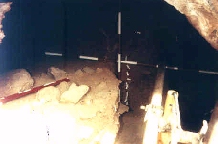
Plate 13: Sima de las Palomas: the extension to the upper cutting under the rocky overhang, excavated from the top of the scaffolding tower, at the end of the 1996 field season. (Photo M. J. Walker)
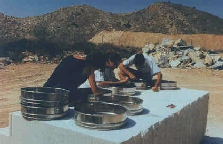
Plate 14: Sima de las Palomas: inspecting sieves after wet-sieving. (Photo M. J. Walker)
Cueva Negra posed different engineering problems. Here, water is pumped up from the river by a portable petrol-driven pump 100m away through a high-pressure hose-pipe, though because the 40m vertical displacement strains its capability we find it best to fill up a 200 litre drum sporadically, drawing water off it by short hose-pipes to play over our nested sieves hung from wooden tripods on the terrace before the cave (Plate 15).

Plate 15: Cueva Negra: wet-sieving on the terracein front of the rock-shelter. (Photo M. J. Walker)
At its mouth, three enormous boulders - fallen from the roof - covered sediments we needed to excavate (Figure 3, Figure 4); our overhead wire reference grid had therefore to be hung 1.5m above the boulders so as to be out of the way of tools wielded to break them up; our small pneumatic drill driven by a portable electricity generator made scant impact on them (Plate 16,Plate 17), so quarrymen brought up a large drill, using 100m of high-pressure hose-pipe from a compressor down by the river.

Plate 16: Cueva Negra before excavation: in the foreground is the Civil War hide-out and a cutting made into it by local archaeologists in 1981; in the backgound are seen the large fallen blocks in the entrance of the rock-shelter, the one on the right lying on a pediment of soil which we wished to excavate because it was the highest undisturbed soil remaining in the cave. (Photo M. J. Walker)
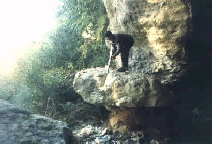
Plate 17: Our attempt to break up one of the rocks in the entrance. (Photo M. J. Walker)
© Internet Archaeology
URL: http://intarch.ac.uk/journal/issue5/walker/3.0.html
Last updated: Wed Dec 23 1998